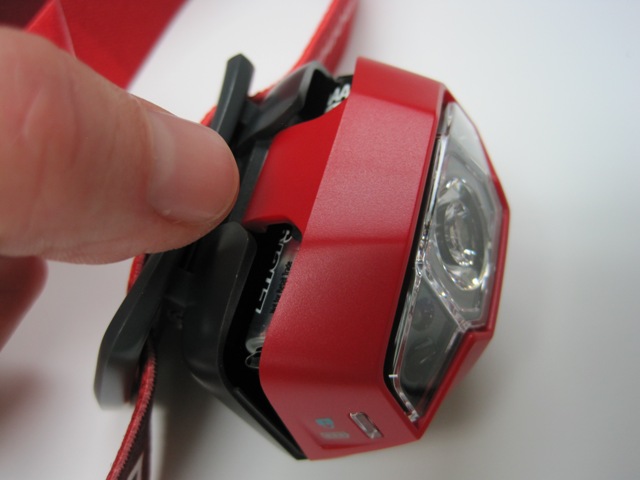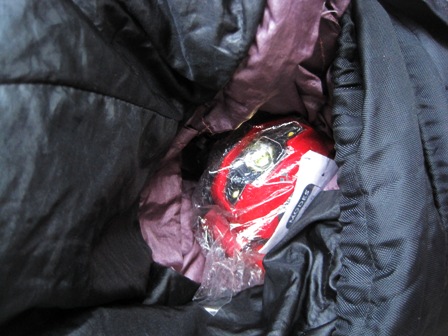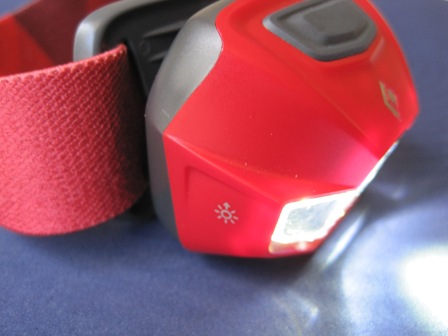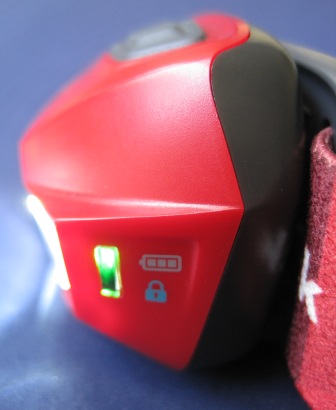|
BLACK DIAMOND SPOT LED HEADLAMP
TEST SERIES BY MARINA BATZKE
LONG-TERM REPORT
September 28, 2014
CLICK HERE TO SKIP TO THE FIELD REPORT
CLICK HERE TO SKIP TO THE LONG-TERM REPORT
TESTER INFORMATION
|
NAME:
|
Marina Batzke
|
|
EMAIL:
|
mbbp2013 (at) hotmail (dot) com
|
|
AGE:
|
54
|
|
LOCATION:
|
Los Angeles County, California, USA
|
|
GENDER:
|
F
|
|
HEIGHT:
|
5' 5" (1.65 m)
|
|
WEIGHT:
|
130 lb (59.00 kg)
|
I converted from day hiking and car camping to backpacking in spring 2013. Since then, I have selectively purchased new, more lightweight gear, while I still carry some heavier gear from my car camping trips. I always hike with a group and I like the gear talk when in camp. I am a tent camper looking for ways to lighten my pack. My backpacking trips are currently weekend excursions in Southern California, USA. If my business travel allows me to get away, I try to backpack one or two weekends a month.
INITIAL REPORT
PRODUCT INFORMATION & SPECIFICATIONS
Manufacturer: Black Diamond Equipment, Ltd.
Year of Test: 2014
Manufacturer's Website: http://blackdiamondequipment.com/
MSRP: US $39.95
Listed Weight: 1.9 oz (54 g) for Spot + 1.3 oz (36 g) for 3 AAA batteries = Total 3.2 oz (90 g)
Measured Weight: 2.1 oz (59 g) for Spot + 1.2 oz (35 g) for 3 AAA batteries = Total 3.3 oz (94 g)
Other details:
Available colors are Fire Red, Matte Black, Revolution Green, Titanium and Ultra White.
 | | My Spot in Fire Red |
INITIAL IMPRESSIONS
The Black Diamond Spot LED headlamp packing unit consists of a sturdy outer cardboard box with a front plastic window and the Spot headlamp well protected inside in a blister package. I almost had to pry open the hard plastic that the Spot plastic lamp body was securely resting in.
I had selected the Spot in my favorite color: red and it looks really good with its bold red hard-plastic lamp body contrasted by black portions. A noticeable black, rubbery-feel button is on the top of Spot. Right below it, there is a tiny silver-colored Black Diamond logo, positioned above the LED window. To the right of this LED window (when I am wearing the Spot) is the PowerTap (Black Diamond Trade Mark term), symbolized by a small sun with an up arrow. To the left of the LED window is a small clear indicator that is used to show both the lockout function (by flashing blue) and the remaining battery power (either flashing green, orange or red), next to the indicator symbolized with a lock symbol and a battery symbol (shown upside down in 2nd photo).
In the LED window itself, I see a big central LED and to the left and right of that, each a small white LED and a small red LED.
The 1 in (2.5 cm) wide adjustable elastic soft-fabric headband shows multiple shades of red in rectangular patterns and has the Black Diamond logo and the wording Black Diamond imprinted in white. I expanded the headband to its maximum length and measured about 24 in (61 cm) circumference. By pulling its looping fabric through a black clasp (plastic adjuster), I loosen or tighten the headband to a comfortable fit around my head and can adjust it, should I wear a hat.
The Spot body is attached to the headband with a black clasp. It is possible to remove the elastic fabric band from this black plastic clasp (by squeezing the fabric through a narrow gap), e.g. to wash the fabric band, should it get sweaty over the years. The black plastic clasp is connected to the Spot body plastic with a hinge. I use this hinge to adjust the pointing angle of Spot's lighting.
READING THE INSTRUCTIONS
This is my first Black Diamond headlamp and the Spot looks way more sophisticated than my previous entry-grade headlamp. So I started out reading the 'Instructions for Use' flyer that came inside the packing unit. The instructions are in English, French, German, Italian, Spanish and Japanese. The text instructions are supported by seven illustrations. I read the instructions in both English and German and each language has proper grammar.
Attached to the headband were summarized brief use instructions (see 1st photo). This brief version uses only illustrations to explain the various Spot features. It is easy to take on a trip and will allow me to refresh my memory on how to use the various functions.
TRYING IT OUT
 | | Spot opens on its bottom side to access battery compartment |
Despite looking at illustration 2 of the 'Instructions for Use', I initially had a hard time finding the opening for Spot's battery compartment. I was worried I would break the headlamp's plastic body. In the end, my thumb finger nail popped off the red plastic portion from the black body portion on the bottom side of Spot, right next to the hinge and the battery compartment opened. It was easy to insert the three packing unit-supplied AAA batteries and easy to close the battery-filled compartment.
I then tried out the various SPOT functions following the 'instructions for use' flyer step by step. Quite an interesting array of features.
One click of the rubbery-feel button on Spot's top side turns on the big white LED. Another click of that button turns it off.
While the big white LED is on, I can adjust its brightness level by constantly pressing onto the black button. First the LED intensity jumps from 75% to 100%, then it starts dimming down to its lowest level and jumps back to 100%. I stop pressing the button when the optimum brightness for the chore at hand is reached.
Two clicks onto the top button turn on the two small white side-LEDs (proximity LEDs) instead. One click on that button turns those two off.
Holding down the top button for three seconds, then releasing it turns on the two red night vision LEDs. If I now turn off the Spot, it will remember the red-light night vision mode. To switch back to white LED, I need to press the top button for three seconds again.
Three quick clicks onto the top button put the Spot in strobe mode.
While I am wearing the Spot, the Black Diamond PowerTap is located to the right of the LED window. I am right-handed, so it is easy to tap onto that sensitive housing area with my right pointing finger and the one big white LED jumps to 100% brightness. A second touch jumps Spot's brightness back to the preset level. This PowerTap only works for the one bright white LED, neither for the two smaller proximity LEDs nor for the two red night vision LEDs.
If I want to pack up the Spot, with power off in white mode, I hold the top button for six seconds. While I keep pressing that button, after 3 seconds the red LEDs briefly flash on. Finally the tiny battery level/lockout meter window (on the left side, while I am wearing the Spot) flashes in blue lighting, indicating the lockout feature is set. Sure enough, when I am trying to click onto the top button, blue flashes in the tiny side indicator window show me: Spot is locked out. To release the lock, I hold down the top button for six seconds again and release it when spot powers up with its big white LED.
FIELD REPORT
FIELD LOCATIONS AND CONDITIONS
Location: Mount Baldy, Southern California, USA
Day Hike. Spot was part of my 10 essentials. June
Temperature: 75 F (24 C)
Elevation: 10,068 ft (3069 m)
Location: San Jacinto, Southern California, USA
Trip duration: 3 days/ 2 nights June
Temperatures: 59-76 F (15-24 C)
Campground Elevation: 9100 ft (2780 m)
Location: Yosemite National Park, Northern California, USA
Trip duration: 4 days/ 3 nights July
Temperatures: 47-79 F (9-26 C)
Campground Elevations: 8600 ft (2600 m) and 6700 ft (2050 m)
Location: San Gorgonio Wilderness, Southern California, USA
Trip duration: 4 days/ 3 nights July
Temperatures: 59-75 F (15-24 C)
Campground Elevation: 9200 ft (2800 m)
PERFORMANCE IN THE FIELD
I have used the Black Diamond Spot LED Headlamp on three California backpacking trips so far. The use has always been for evening chores in camp, i.e. cleaning up after dinner, getting my campsite ready for the night and inside the tent before turning in for the night. I have not hiked with Spot on the trail.
Each time I packed for my backpacking trips, I securely stored Spot inside a small plastic bag. Because Spot has so many lamp settings, I took the "brief use instructions" along on my trips. To protect Spot from accidentally turning on, I made sure to use the locking function. To protect Spot from impact, I stored the headlamp inside my sleeping bag. Once I arrived in camp, set up my tent and unpacked the mattress pad and sleeping bag, I unpacked Spot, ready to use it when darkness approached.
 | | Spot tugged inside my sleeping bag |
During the summer months, it usually is dark around 8.30 pm in California. On my three recent overnight trips, I always had dinner when it was still light out, so I did not need Spot to illuminate my cooking chores. Yet I used Spot to clean up after dinner which involved getting any scented items into the bear canister and making sure the campsite was clean of any items that could attract critters.
I noticed that the red lamp brightness was not sufficient for any activities that were not close at hand. The red light was fine if I had a chore right in front of me at arm's length, like stuffing the bear canister or putting tooth paste on the brush. Because California has not had enough rain and all campgrounds are very dry, campfires are not allowed and the red light always worked great when chatting with hiking buddies without the aid of a camp fire. Yet whenever I wanted to illuminate a wider area, e.g. scanning my cooking area for anything that needed to get packed up or while walking, I just did not feel the red light gave me enough brightness.
Instead I used the big white LED and dimmed it by pressing onto the top black rubber button until I felt comfortable with the intensity level. This way, I was safely able to walk up to my tent from the cooking area or walk to the bear canister, stored away from both tent and cooking area. Spot's white LED was super bright in these situations.
Also, even though Spot has the tapping function on the outside case that works with the big white LED, I mostly used the big black rubber button on top to dim the white LED light to a comfortable level. I felt more comfortable pressing that big button versus tapping at the headlamp shell.
At night, I stored Spot in the ceiling storage (small loft) of my tent to have it handy. On the day of packing up for the hike back to the trailhead, I had to remember to turn on the lock function, so Spot would not accidentally turn on inside my sleeping bag.
Overall, I have used Spot for approximately five hours so far. I typically did not have to have it burn consistently for an hour or so but instead turned Spot on when I needed it. The battery load indicator still shows green.
SUMMARY
Even though Spot has a lot of different functions, I have mostly used the big white LED so far and have appreciated the super brightness it provides. Occasionally I have used the red light function. I feel the lockout function is very important to avoid battery drain. I have not once used the Strobe feature.
I like Spot's bright red color which makes it easy to find it. The headband is easy to adjust to fit well whether I am wearing Spot with or without a warm knit hat at night.
LONG-TERM REPORT
LONG-TERM TEST LOCATIONS AND CONDITIONS
Location: Sugarloaf Mountain, Southern California, USA
Trip duration: 1 day August
On-trail hiking with evening spent in Big Bear town.
Temperatures: 55-75 F (13-24 C)
Location: Innsbruck, Austria to Bozen, Italy
Trip duration: 6 days September
Bicycle Tour
Daytime Temperatures: 61-79 F (16-26 C)
PERFORMANCE IN THE FIELD
After the Sugarloaf Mountain day hike, I used the Spot headlamp during a walk through the Big Bear neighborhood that evening.
During the bike trip in Europe, I used the Spot headlamp on two nights when we went for after-dinner walks. We stayed in small remote villages with very limited street lighting. After dinner, we walked our meals off with a stroll through the small village streets.
In each of those cases, I used the bright white LED and really appreciated its brightness and illumination far ahead.
SUMMARY
Looking back at the entire test period, I am realizing that I have mostly used the bright white LED. It is just the easiest, quickest way to press on that big button to change the brightness level. I simply keep pressing on that black rubber button until I have the illumination that I need at that moment.
I have only rarely used the PowerTap feature on the right side of the headlamp body. It just was not intuitive for me to keep tapping at the headlamp body for brightness adjustment.
 | | I only rarely used the PowerTap feature |
I have sporadically used the red light feature but only rarely the two white LEDs and not once the strobe function.
PROS:
+ Very bright, far reaching bright white LED.
+ Big rubber button on top allows for ideal brightness adjustment for the task at hand.
+ Lockout feature.
+ Battery life indicator.
+ Attractive red lamp body and headband color.
 | | Green light shows more than half of battery power remaining |
CONS:
- Working the many available features was not intuitive to me.
- Red light not very bright.
CONTINUED USE
The Spot is now my preferred headlamp on outings. Even though I am not using its wide array of illumination features, I am very satisfied with the bright white LED.
My thanks to Black Diamond and BackpackGearTest.org for the opportunity to test the Spot headlamp.
Marina Batzke
This report was created with the BackpackGearTest.org Report Writer Version 1.
Copyright 2014. All rights reserved.
Read more reviews of Black Diamond gear
Read more gear reviews by Marina Batzke
|




